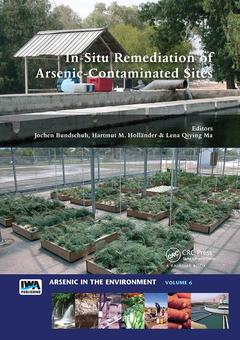Description
In-Situ Remediation of Arsenic-Contaminated Sites
Arsenic in the environment Series
Coordinators: Bundschuh Jochen, Holländer Hartmut M., Ma Lena Qiying
Language: English
Subjects for In-Situ Remediation of Arsenic-Contaminated Sites:
Keywords
Pteris Vittata; permeable; Electrokinetic Remediation; reactive; Retama Sphaerocarpa; barrier; Chromated Copper Arsenate; concentrations; Pityrogramma Calomelanos; pteris; Effective Ionic Mobility; vittata; Fe Dosage; contamination; Electrokinetic Removal; electrokinetic; Reactive Transport Models; retama; Arsenic Concentration; sphaerocarpa; In-situ Chemical Oxidation; PRBs; Soil Arsenic; SCMs; Arsenic Contamination; Cd Spiked; Electrokinetic Process; Frond Biomass; Si Fertilization; EDR; Arsenate Reductase; Arsenic Influx; Reactive Transport; Electroosmotic Flow Rate; Aeration Tank
Publication date: 01-2018
· 17.4x24.6 cm · Paperback
Publication date: 11-2014
208 p. · 17.4x24.6 cm · Hardback
Description
/li>Contents
/li>Readership
/li>Biography
/li>
Providing an introduction, the scientific background, case studies and future perspectives of in-situ arsenic remediation technologies for soils, soil water and groundwater at geogenic and anthropogenic contaminated sites. The case studies present in-situ technologies about natural arsenic, specifically arsenate and arsenite, but also about organic arsenic compounds. This work covers geochemical, microbiological and plant ecological solutions for arsenic remediation.
It will serve as a standard textbook for (post-)graduate students and researchers in the field of Environmental Sciences and Hydrogeochemistry as well as researchers, engineers, environmental scientists and chemists, toxicologists, medical scientists and even for general public seeking an in-depth view of arsenic which had been classed as a carcinogen. This book aims to stimulate awareness among administrators, policy makers and company executives of in-situ remediation technologies at sites contamined by arsenic and to improve the international cooperation on the subject.
1) Introduction to in-situ remediation
SECTION I: FUNDAMENTALS AND BACKGROUND
2) Background of in-situ remediation
a. Geochemical background of in-situ remediation
b. Microbial background of in-situ remediation
c. Phytoremediation background
d. Engineering and technical background (e.g. monitoring & reactive zones/barriers)
e. Numerical modelling
3) Remediation technologies
a. Subterrean in-situ remediation (aquifer)
b. Phytoremediation (soils)
c. Electrokinetic remediation (soils)
d. Reactive barriers
SECTION II: CASE STUDIES
4) Soils (unsaturated zone)
a. Electrokinetic remediation of arsenic-contaminated soils
b. One more case study - phytoremediation
5) Geogenic contaminated sites
a. Subsurface removal of iron and arsenic in Bangla Desh
b. One more case study
6) Mining-related contaminated sites
7) Anthropogenic contaminated sites
a. In situ remediation of arsenic at a highly contaminated site
b. One more case study (NN) / e.g. case study reactive barrier
c. (Monitoring of) natural attenuation
8) Technical sustainability of in-situ remediation
9) Ecological sustainability of in-situ remediation
10) Economical sustainability of in-situ remediation
11) Modeling of in-situ remediation methods and prediction
Jochen Bundschuh (1960, Germany), finished his PhD on numerical modeling of heat transport in aquifers in Tübingen in 1990. He is working in geothermics, subsurface and surface hydrology and integrated water resources management, and connected disciplines. Hartmut Holländer is a civil engineer specialized in numerical groundwater modeling. He covers the undergraduate and graduate courses of Groundwater Hydrology, Groundwater Contamination, and Groundwater and Solute Transport Modelling at the University of Manitoba. Lena Q. Ma is a Professor in the Soil and Water Science Department at the University of Florida. Professor Ma published nearly 200 refereed journal articles and book chapters.
These books may interest you

Arsenic in Drinking Water and Food 210.99 €

Arsenic in Drinking Water and Food 147.69 €


